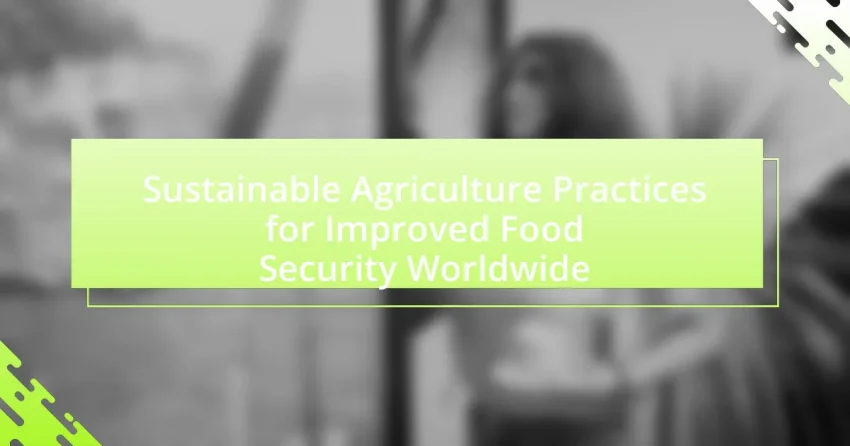Sustainable agriculture practices are essential methods aimed at meeting current food needs while ensuring environmental preservation for future generations. This article explores various sustainable practices, including crop rotation, agroforestry, organic farming, and integrated pest management, highlighting their contributions to food security and environmental health. Key principles such as maintaining soil health, conserving water, and promoting biodiversity are discussed, along with the role of local communities and technological innovations in enhancing agricultural productivity. Additionally, the article addresses the challenges and economic barriers to implementing sustainable agriculture, emphasizing the importance of policy frameworks and community involvement in achieving long-term food security and ecological balance.

What are Sustainable Agriculture Practices?
Sustainable agriculture practices are methods that aim to meet current food needs while preserving the environment for future generations. These practices include crop rotation, agroforestry, organic farming, and integrated pest management, which enhance soil health, conserve water, and reduce chemical inputs. Research indicates that sustainable agriculture can increase food security by improving crop yields and resilience against climate change, as demonstrated in studies by the Food and Agriculture Organization, which found that sustainable practices can lead to a 20-30% increase in productivity in various regions.
How do Sustainable Agriculture Practices contribute to Food Security?
Sustainable agriculture practices contribute to food security by enhancing agricultural productivity while preserving environmental health. These practices, such as crop rotation, agroforestry, and organic farming, improve soil fertility and biodiversity, leading to increased yields. For instance, a study published in the journal “Nature” found that organic farming can yield up to 20% more food per unit area compared to conventional methods, particularly in regions with high biodiversity. Additionally, sustainable practices reduce dependency on chemical inputs, which can be costly and harmful to ecosystems, thereby ensuring a more stable food supply. By promoting resilience against climate change and reducing resource depletion, sustainable agriculture directly supports long-term food security for growing populations.
What are the key principles of Sustainable Agriculture?
The key principles of Sustainable Agriculture include maintaining soil health, conserving water, promoting biodiversity, and reducing chemical inputs. Maintaining soil health involves practices such as crop rotation and cover cropping, which enhance soil fertility and structure. Conserving water is achieved through efficient irrigation techniques and rainwater harvesting, which are essential in areas facing water scarcity. Promoting biodiversity involves integrating various crops and livestock to create resilient ecosystems, which can better withstand pests and diseases. Reducing chemical inputs focuses on minimizing the use of synthetic fertilizers and pesticides, thereby decreasing environmental pollution and enhancing ecosystem health. These principles are supported by research indicating that sustainable practices can lead to increased agricultural productivity while preserving natural resources for future generations.
How do these principles enhance food production?
Sustainable agriculture principles enhance food production by promoting practices that increase efficiency, reduce waste, and improve soil health. These principles, such as crop rotation, agroforestry, and organic farming, lead to higher yields and resilience against pests and climate change. For instance, a study published in the journal “Nature Sustainability” found that farms employing sustainable practices can yield up to 30% more food compared to conventional methods while using fewer resources. This demonstrates that integrating sustainable practices not only boosts food production but also contributes to long-term agricultural viability.
Why is Sustainable Agriculture important for the environment?
Sustainable agriculture is important for the environment because it promotes practices that protect natural resources and biodiversity. By utilizing methods such as crop rotation, organic farming, and reduced chemical inputs, sustainable agriculture minimizes soil degradation and water pollution. For instance, a study by the Food and Agriculture Organization (FAO) indicates that sustainable practices can enhance soil health, leading to increased carbon sequestration and reduced greenhouse gas emissions. This approach not only conserves ecosystems but also supports resilience against climate change, making it essential for long-term environmental health.
What environmental challenges does Sustainable Agriculture address?
Sustainable agriculture addresses several environmental challenges, including soil degradation, water scarcity, loss of biodiversity, and climate change. Soil degradation occurs due to practices like monoculture and excessive use of chemical fertilizers, which diminish soil health and fertility. Water scarcity is exacerbated by inefficient irrigation practices and over-extraction of water resources, leading to reduced availability for crops and ecosystems. Loss of biodiversity results from habitat destruction and the use of pesticides, which threaten various species and disrupt ecosystems. Climate change is addressed through practices that reduce greenhouse gas emissions and enhance carbon sequestration, such as agroforestry and organic farming. These practices collectively contribute to a more resilient agricultural system that can sustain food security while minimizing environmental impact.
How does Sustainable Agriculture promote biodiversity?
Sustainable agriculture promotes biodiversity by implementing practices that enhance ecosystem health and resilience. These practices include crop rotation, polyculture, and organic farming, which support a variety of species and reduce reliance on chemical inputs. For instance, crop rotation helps maintain soil fertility and disrupts pest cycles, while polyculture increases habitat diversity, allowing different species to thrive. Research indicates that farms employing sustainable practices can host up to 50% more species compared to conventional farms, demonstrating a clear link between sustainable agriculture and increased biodiversity.
What role do local communities play in Sustainable Agriculture?
Local communities play a crucial role in sustainable agriculture by implementing practices that enhance food security and environmental health. They contribute local knowledge and traditional farming techniques that promote biodiversity and soil health, which are essential for sustainable crop production. For instance, community-led initiatives often focus on organic farming, agroecology, and permaculture, which have been shown to increase resilience against climate change and improve yields. Research indicates that regions with strong community involvement in agriculture report higher levels of food security and better nutritional outcomes, as seen in studies conducted by the Food and Agriculture Organization. Thus, local communities are integral to the success of sustainable agriculture, driving practices that ensure long-term food security and ecological balance.
How can community involvement improve food security?
Community involvement can improve food security by fostering local agricultural initiatives and enhancing resource sharing among residents. When communities actively participate in food production, they can implement sustainable practices tailored to their specific environments, leading to increased crop yields and reduced dependency on external food sources. For instance, community gardens and cooperative farming have been shown to boost local food availability, as evidenced by a study from the University of California, which found that community gardens can increase access to fresh produce by up to 40% in urban areas. Additionally, community engagement in food distribution networks can minimize food waste and ensure that surplus food reaches those in need, further strengthening food security.
What are examples of successful community-led Sustainable Agriculture initiatives?
Successful community-led sustainable agriculture initiatives include the “Community Supported Agriculture” (CSA) model, which connects local farmers directly with consumers, ensuring fresh produce and financial support for farmers. Another example is the “Participatory Guarantee Systems” (PGS), which involves local stakeholders in the certification process of organic products, enhancing trust and community engagement. Additionally, the “Agroecology movement” promotes sustainable farming practices through local knowledge and biodiversity, exemplified by initiatives in Brazil where communities have successfully restored degraded lands and improved food security. These initiatives demonstrate effective collaboration and resource management, leading to enhanced food security and environmental sustainability.
How can technology enhance Sustainable Agriculture Practices?
Technology enhances sustainable agriculture practices by increasing efficiency, reducing resource consumption, and improving crop yields. Precision agriculture technologies, such as GPS-guided equipment and soil sensors, allow farmers to apply water, fertilizers, and pesticides more accurately, minimizing waste and environmental impact. For instance, a study by the Food and Agriculture Organization (FAO) indicates that precision agriculture can reduce fertilizer use by up to 30%, leading to lower costs and decreased runoff into waterways. Additionally, data analytics and machine learning can optimize planting schedules and crop management, resulting in higher productivity. The integration of these technologies supports sustainable practices by promoting resource conservation and enhancing food security.
What technological innovations are currently being used?
Technological innovations currently being used in sustainable agriculture include precision farming, vertical farming, and the use of drones for crop monitoring. Precision farming utilizes data analytics and GPS technology to optimize field-level management regarding crop farming. This approach has been shown to increase crop yields by up to 20% while reducing input costs. Vertical farming employs controlled-environment agriculture technology to grow crops in stacked layers, significantly reducing land use and water consumption by up to 90%. Drones are increasingly used for aerial imagery and real-time monitoring of crop health, allowing farmers to make informed decisions quickly, which can lead to a 15% increase in productivity. These innovations collectively contribute to improved food security by enhancing efficiency and sustainability in agricultural practices.
How do these technologies improve efficiency and yield?
Technologies such as precision agriculture, biotechnology, and data analytics improve efficiency and yield by optimizing resource use and enhancing crop performance. Precision agriculture employs GPS and IoT sensors to monitor field variability, allowing farmers to apply water, fertilizers, and pesticides more accurately, which reduces waste and increases productivity. Biotechnology, including genetically modified organisms (GMOs), enhances crop resilience to pests and environmental stressors, leading to higher yields. Data analytics enables farmers to make informed decisions based on real-time data, improving overall farm management. For instance, a study by the Food and Agriculture Organization (FAO) indicates that precision agriculture can increase crop yields by 10-30% while reducing input costs by up to 20%.

What are the challenges facing Sustainable Agriculture?
The challenges facing sustainable agriculture include climate change, soil degradation, water scarcity, and economic viability. Climate change affects crop yields and increases the frequency of extreme weather events, making it difficult for farmers to maintain consistent production levels. Soil degradation, caused by practices such as over-farming and chemical use, reduces soil fertility and biodiversity, which are essential for sustainable crop growth. Water scarcity, exacerbated by climate change and over-extraction, limits irrigation options and threatens food production. Economic viability is also a significant challenge, as many sustainable practices require upfront investment and may not yield immediate financial returns, making it difficult for farmers to adopt them. These challenges collectively hinder the ability to achieve food security while promoting environmentally friendly agricultural practices.
What economic barriers exist for implementing Sustainable Agriculture?
Economic barriers for implementing sustainable agriculture include high initial investment costs, limited access to credit, and market access challenges. High initial investment costs arise from the need for new technologies, infrastructure, and training, which can deter farmers from transitioning to sustainable practices. Limited access to credit restricts farmers’ ability to finance these investments, particularly in developing regions where financial institutions may be hesitant to lend for perceived high-risk ventures. Additionally, market access challenges, such as the lack of established supply chains for sustainably produced goods, can hinder farmers from selling their products at competitive prices, further discouraging the adoption of sustainable agriculture practices.
How do market dynamics affect the adoption of Sustainable Practices?
Market dynamics significantly influence the adoption of sustainable practices by shaping consumer demand, pricing strategies, and competitive pressures. For instance, increasing consumer awareness and preference for environmentally friendly products drive businesses to adopt sustainable practices to meet market expectations. According to a Nielsen report, 66% of global consumers are willing to pay more for sustainable brands, indicating that market demand can incentivize companies to implement sustainable practices. Additionally, regulatory frameworks and market incentives, such as subsidies for sustainable farming, further encourage the adoption of these practices by reducing financial barriers. Thus, the interplay of consumer preferences, regulatory influences, and competitive market conditions directly impacts the extent to which sustainable practices are embraced in agriculture.
What financial support options are available for farmers?
Farmers have access to various financial support options, including government grants, low-interest loans, and subsidies. Government grants, such as those provided by the USDA in the United States, help farmers invest in sustainable practices and technologies. Low-interest loans, often available through agricultural banks or cooperatives, enable farmers to finance equipment and operational costs. Additionally, subsidies for specific crops or practices can reduce financial burdens, encouraging sustainable agriculture. For instance, the Conservation Reserve Program offers payments to farmers who implement environmentally beneficial practices on their land, demonstrating the government’s commitment to supporting sustainable agriculture.
How do policy frameworks impact Sustainable Agriculture?
Policy frameworks significantly impact sustainable agriculture by establishing regulations, incentives, and guidelines that promote environmentally friendly practices. These frameworks can encourage the adoption of sustainable methods through subsidies for organic farming, restrictions on harmful pesticides, and support for research in sustainable technologies. For instance, the European Union’s Common Agricultural Policy allocates funds to farmers who implement sustainable practices, thereby directly influencing agricultural methods and improving food security. Additionally, policies that prioritize land conservation and water management contribute to the long-term viability of agricultural systems, ensuring that they meet current and future food demands.
What policies support Sustainable Agriculture initiatives?
Policies that support Sustainable Agriculture initiatives include the implementation of subsidies for organic farming, regulations promoting agroecological practices, and incentives for conservation tillage. These policies encourage farmers to adopt environmentally friendly practices that enhance soil health and biodiversity. For instance, the European Union’s Common Agricultural Policy allocates funds specifically for sustainable farming practices, which has led to a significant increase in organic farming across member states. Additionally, the U.S. Department of Agriculture offers programs that provide financial assistance to farmers who implement sustainable practices, demonstrating a commitment to improving food security while protecting natural resources.
How can policy changes improve food security outcomes?
Policy changes can improve food security outcomes by implementing regulations that promote sustainable agricultural practices, enhance access to resources, and support local food systems. For instance, policies that incentivize organic farming and agroecological methods can lead to increased crop yields and biodiversity, which are essential for resilient food systems. Research indicates that countries adopting such policies have seen significant improvements in food availability and nutritional quality. A study by the Food and Agriculture Organization (FAO) highlights that nations with supportive agricultural policies experience a 20% increase in food production efficiency, directly correlating to enhanced food security.
What are the social implications of Sustainable Agriculture?
Sustainable agriculture has significant social implications, including enhanced community resilience and improved food security. By promoting local food systems, sustainable agriculture fosters community engagement and strengthens social ties among farmers and consumers. Research indicates that sustainable practices can lead to increased access to nutritious food, particularly in underserved areas, thereby addressing food insecurity. For instance, a study by the Food and Agriculture Organization (FAO) highlights that sustainable agricultural practices can improve the livelihoods of smallholder farmers, which in turn supports local economies and reduces poverty levels. Additionally, sustainable agriculture encourages equitable resource distribution, empowering marginalized groups, particularly women, in agricultural decision-making processes.
How does Sustainable Agriculture affect rural livelihoods?
Sustainable agriculture positively affects rural livelihoods by enhancing food security, increasing income stability, and promoting environmental health. By implementing practices such as crop rotation, agroforestry, and organic farming, rural communities can improve soil fertility and reduce dependency on chemical inputs, leading to higher yields and better-quality produce. According to the Food and Agriculture Organization, sustainable agricultural practices can increase farm productivity by up to 30%, directly benefiting farmers’ incomes and food availability in rural areas. Additionally, these practices contribute to biodiversity conservation, which supports ecosystem services essential for agriculture, thereby ensuring long-term sustainability and resilience in rural livelihoods.
What role does education play in promoting Sustainable Practices?
Education plays a crucial role in promoting sustainable practices by equipping individuals with the knowledge and skills necessary to implement environmentally friendly methods. Through education, people learn about the importance of sustainability, the impact of their actions on the environment, and effective strategies for resource management. For instance, studies show that agricultural education programs significantly increase farmers’ adoption of sustainable practices, leading to improved crop yields and reduced environmental degradation. Research conducted by the Food and Agriculture Organization highlights that educated farmers are more likely to utilize sustainable techniques, such as crop rotation and organic farming, which contribute to food security and environmental health.

What are the best practices for implementing Sustainable Agriculture?
The best practices for implementing sustainable agriculture include crop rotation, agroforestry, integrated pest management, and organic farming techniques. Crop rotation enhances soil fertility and reduces pest and disease cycles, while agroforestry combines agriculture with tree planting to improve biodiversity and soil health. Integrated pest management minimizes chemical use by employing biological control methods, and organic farming avoids synthetic fertilizers and pesticides, promoting ecological balance. According to the Food and Agriculture Organization, these practices contribute to increased resilience against climate change and improved food security by maintaining productive ecosystems.
How can farmers transition to Sustainable Agriculture?
Farmers can transition to sustainable agriculture by adopting practices such as crop rotation, organic farming, and integrated pest management. These methods enhance soil health, reduce chemical inputs, and promote biodiversity. For instance, a study published in the journal “Agriculture, Ecosystems & Environment” found that crop rotation can increase yields by up to 20% while decreasing the need for synthetic fertilizers. Additionally, implementing organic farming techniques can lead to a 30% reduction in greenhouse gas emissions compared to conventional methods. By integrating these sustainable practices, farmers not only improve their productivity but also contribute to environmental conservation and food security.
What steps should be taken for effective transition?
To achieve an effective transition to sustainable agriculture practices, stakeholders must implement a series of strategic steps. First, conducting a comprehensive assessment of current agricultural practices is essential to identify areas for improvement. This assessment should include evaluating soil health, water usage, and biodiversity levels.
Next, stakeholders should develop a clear transition plan that outlines specific goals, timelines, and resource allocations. This plan must incorporate training programs for farmers to educate them on sustainable techniques such as crop rotation, agroforestry, and organic farming methods.
Additionally, establishing partnerships with local governments, NGOs, and research institutions can provide the necessary support and resources for successful implementation. Financial incentives, such as subsidies or grants for adopting sustainable practices, can further encourage farmers to make the transition.
Monitoring and evaluation mechanisms should be put in place to assess the effectiveness of the transition and make adjustments as needed. Evidence from various studies indicates that regions adopting sustainable practices have seen improvements in crop yields and soil health, demonstrating the viability of these steps for effective transition.
What resources are available for farmers during this transition?
Farmers transitioning to sustainable agriculture have access to various resources, including government programs, financial assistance, educational materials, and technical support. Government initiatives, such as the USDA’s Sustainable Agriculture Research and Education (SARE) program, provide grants and resources to promote sustainable practices. Financial assistance can come from loans and subsidies aimed at supporting farmers in adopting eco-friendly methods. Educational resources, including workshops and online courses, help farmers learn about sustainable techniques and best practices. Additionally, local agricultural extension services offer technical support and guidance tailored to specific regional needs, ensuring farmers have the necessary tools and knowledge to successfully transition.
What are the most effective Sustainable Agriculture techniques?
The most effective sustainable agriculture techniques include crop rotation, agroforestry, conservation tillage, integrated pest management, and organic farming. Crop rotation enhances soil fertility and reduces pest and disease cycles by alternating different crops in a specific sequence. Agroforestry combines agriculture and forestry practices, improving biodiversity and soil health while providing additional income sources. Conservation tillage minimizes soil disturbance, preserving soil structure and moisture, which leads to better crop yields. Integrated pest management employs a combination of biological, cultural, and chemical practices to control pests sustainably, reducing reliance on synthetic pesticides. Organic farming focuses on using natural inputs and practices to maintain soil health and ecosystem balance, which has been shown to improve long-term agricultural productivity. These techniques collectively contribute to enhanced food security by promoting resilient agricultural systems.
How does crop rotation contribute to sustainability?
Crop rotation contributes to sustainability by enhancing soil health, reducing pest and disease pressure, and improving crop yields. By alternating different crops in a specific sequence, soil nutrients are replenished, which minimizes the need for chemical fertilizers. Research indicates that crop rotation can increase soil organic matter by up to 30%, leading to improved soil structure and fertility. Additionally, rotating crops disrupts the life cycles of pests and diseases, reducing reliance on pesticides and promoting biodiversity. Studies have shown that farms practicing crop rotation can achieve yield increases of 10-20% compared to monoculture systems, thereby supporting food security while maintaining ecological balance.
What is the role of organic farming in Sustainable Agriculture?
Organic farming plays a crucial role in sustainable agriculture by promoting biodiversity, enhancing soil health, and reducing chemical inputs. This farming method utilizes natural processes and materials, which helps maintain ecological balance and supports the long-term viability of agricultural systems. Research indicates that organic farming can improve soil organic matter, leading to better water retention and nutrient availability, which are essential for crop productivity. According to the Rodale Institute’s research, organic farming systems can yield comparable or even higher outputs than conventional systems while using fewer resources and contributing to environmental sustainability.
What practical tips can enhance Sustainable Agriculture efforts?
Implementing crop rotation can significantly enhance sustainable agriculture efforts by improving soil health and reducing pest and disease cycles. Crop rotation involves alternating the types of crops grown in a particular area, which helps maintain nutrient levels in the soil and minimizes the need for chemical fertilizers. Research indicates that farms practicing crop rotation can yield up to 20% more than those that do not, as diverse crops can better utilize soil nutrients and reduce erosion. Additionally, integrating cover crops can further enhance soil structure and fertility, while also preventing weed growth and protecting against soil erosion. Studies show that cover crops can increase organic matter in the soil by 1-2% annually, contributing to long-term sustainability.
How can farmers measure the success of their Sustainable Practices?
Farmers can measure the success of their sustainable practices through various metrics, including yield improvements, soil health assessments, and biodiversity indicators. Yield improvements can be quantified by comparing crop outputs before and after implementing sustainable methods, such as crop rotation or organic fertilization. Soil health assessments involve testing soil composition and fertility, which can show enhancements in nutrient levels and microbial activity due to sustainable practices. Biodiversity indicators can be evaluated by monitoring the presence of various species in the ecosystem, which often increases with sustainable farming techniques. Research has shown that farms employing sustainable practices can experience yield increases of 20-30% while improving soil quality and biodiversity, thus demonstrating the effectiveness of these methods in enhancing agricultural sustainability.
What common mistakes should be avoided in Sustainable Agriculture?
Common mistakes to avoid in sustainable agriculture include over-reliance on monocultures, neglecting soil health, and inadequate water management. Monocultures can lead to decreased biodiversity and increased vulnerability to pests and diseases, as evidenced by studies showing that diverse cropping systems enhance resilience. Neglecting soil health can result in nutrient depletion and reduced crop yields; research indicates that practices like crop rotation and cover cropping significantly improve soil quality. Inadequate water management can lead to inefficient water use and increased salinity, with data showing that integrated water management practices can enhance water efficiency by up to 30%.
